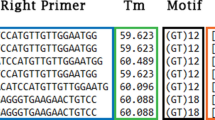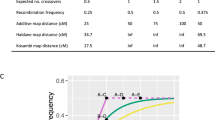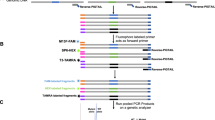Abstract
To facilitate large–scale genetic mapping of the human genome, we have developed chromosome–specific sets of microsatellite marker loci suitable for use with a fluorescence–based automated DNA fragment analyser. We present 254 dinucleotide repeat marker loci (80% from the Généthon genetic linkage map) arranged into 39 sets, covering all 22 autosomes and the X chromosome. The average distance between adjacent markers is 13 centiMorgans, and less than 4% of the genome lies more than 20 cM from the nearest marker. Each set of microsatellites consists of up to nine marker loci, with allele size ranges that do not overlap. We selected marker loci on the basis of their reliability in the polymerase chain reaction, polymorphism content, map position and the accuracy with which alleles can be scored automatically by the Genotyper™ program.
This is a preview of subscription content, access via your institution
Access options
Subscribe to this journal
Receive 12 print issues and online access
$209.00 per year
only $17.42 per issue
Buy this article
- Purchase on Springer Link
- Instant access to full article PDF
Prices may be subject to local taxes which are calculated during checkout
Similar content being viewed by others
References
Weber, J.L. & May, P.E. Abundant class of human DNA polymorphisms which can be typed using the polymerase chain reaction. Am. J. hum. Genet. 44, 338–396 (1989).
NIH/CEPH Collaborative Mapping Group. A comprehensive genetic linkage map of the human genome. Science 258, 67–86 (1992).
Weissenbach, J. et al. A second-generation linkage map of the human genome. Nature 359, 794–801 (1992).
Gyapay, G. et al. 1993–1994 Généthon Human Genetic Linkage Map. Nature Genet. 7, 246–248 (1994).
Matise, T.C., Perlin, M. & Chakravarti, A. Automated construction of genetic linkage maps using an expert system (MultiMap): a human genome linkage map. Nature Genet. 6, 384–390 (1994).
Buetow, K.H. et al. Integrated human genome-wide maps constructed using the CEPH reference panel. Nature Genet. 6, 391–393 (1994).
Hilbert, P. et al. Chromosomal mapping of two genetic loci associated with blood-pressure regulation in hereditary hypertensive rats. Nature 353, 521–529 (1991).
Rise, M.L., Frankel, W.N., Coffin, J.M. & Seyfried, T.N. Genes for epilepsy mapped in the mouse. Science 253, 669–673 (1991).
Todd, J.A. et al. Genetic analysis of autoimmune type 1 diabetes mellitus in mice. Nature 351, 542–547 (1991).
Beckmann, J.S. et al. A linkage map of human chromosome 15 with an average resolution of 2 cM and containing 55 polymorphic microsatellites. Hum. molec. Genet. 2, 2019–2030 (1993).
Smeets, H.J.M., Brunner, H.G., Ropers, H.H. & Wieringa, B. Use of variable simple sequence motifs as genetic markers: Application to study of myotonic dystrophy. Hum. Genet. 83, 245–251 (1989).
Diehl, S.R., Ziegle, J., Buck, G.A., Reynolds, T.R. & Weber, J.L. Automated genotyping of human DNA polymorphisms. Am. J. hum. Genet. 47, A177 (1990).
Edwards, A., Civitello, A., Hammond, H.A. & Caskey, C.T. DNA typing and genetic mapping with trimeric and tetrameric tandem repeats.Am. J. hum. Genet. 49, 746–756 (1991).
Ziegle, J.S. et al. Application of automated DNA sizing technology for genotyping microsatellite loci. Genomics 14, 1026–1031 (1992).
Schwengel, D.A., Jedlicka, A.E., Nanthakumara, E.J., Weber, J.L. & Levitt, R.C. Comparison of fluorescence-based semi-automated genotyping of multiple microsatellite loci with autoradiographic techniques. Genomics (in the press).
Callen, D.F. et al. Incidence and origin of “null” alleles in the (AC)n microsatellite markers. Am. J. hum. Genet. 52, 922–927 (1993).
Bain, S.C. et al. lnsulin gene region-encoded susceptibility to type1 diabetes is not restricted to HLA-DR4-positive individuals. Nature Genet. 2, 212–215 (1992).
Lander, E.S. & Green, P. Construction of multilocus genetic linkage maps in humans. Proc. natn. Acad. Sci. U.S.A. 84, 2363–2367 (1987).
Lathrop, G.M., Lalouel, J.M., Julier, C. & Ott, J. Strategies for multipoint linkage analysis in humans. Proc. natn. Acad. Sci U.S.A. 81, 3443–3446 (1987).
Author information
Authors and Affiliations
Rights and permissions
About this article
Cite this article
Reed, P., Davies, J., Copeman, J. et al. Chromosome–specific microsatellite sets for fluorescence–based, semi–automated genome mapping. Nat Genet 7, 390–395 (1994). https://doi.org/10.1038/ng0794-390
Received:
Accepted:
Issue Date:
DOI: https://doi.org/10.1038/ng0794-390
This article is cited by
-
Development and transferability of two multiplexes nSSR in Scots pine (Pinus sylvestris L.)
Journal of Forestry Research (2015)
-
A novel autosomal dominant condition consisting of congenital heart defects and low atrial rhythm maps to chromosome 9q
European Journal of Human Genetics (2011)
-
Genetic diversity, seed size associations and population structure of a core collection of common beans (Phaseolus vulgaris L.)
Theoretical and Applied Genetics (2009)
-
Fatty liver and obesity: phenotypically correlated but genetically distinct traits in a mouse model of type 2 diabetes
Diabetologia (2007)
-
Linkage and potential association of obesity-related phenotypes with two genes on chromosome 12q24 in a female dizygous twin cohort
European Journal of Human Genetics (2006)



